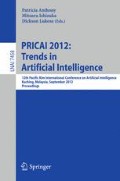Abstract
In this paper, we present a method for estimating the sentiment polarity of Japanese sentences including onomatopoeic words. Onomatopoeic words imitate the sounds they represent and can help us understand the sentiment of the sentence. Although there are many onomatopoeic words in Japanese, conventional sentiment classification methods have not taken them into consideration. The sentiment polarity of onomatopoeic words can be estimated using the sound symbolism derived from their vocal sounds. Our experimental results show that the proposed method with sound symbolism can significantly outperform the baseline method that is not with sound symbolism.
Access this chapter
Tax calculation will be finalised at checkout
Purchases are for personal use only
Preview
Unable to display preview. Download preview PDF.
References
Cortes, C., Vapnik, V.: Support-vector networks. Machine Learning 20(3), 273–297 (1995)
David, C.: A Dictionary of Linguistics and Phonetics. Wiley-Blackwell (2008)
Fellbaum, C.: WordNet: An Electronic Lexical Database. MIT Press (1998)
Hamano, S.: The Sound-Symbolic System of Japanese. CSLI Publications (1998)
Hida, Y., Asada, H.: Gendai Giongo Gitaigo Yoho Jiten. Tokyo-do (2002) (in Japanese) ISBN: 9784490106107
Kamps, J., Marx, M., Mokken, R.J., de Rijke, M.: Using Wordnet to Measure Semantic Orientations of Adjectives. In: Proceedings of the 4th International Conference on Language Resources and Evaluation (LREC 2004), pp. 1115–1118 (2004)
Köhler, W.: Gestalt Psychology. Liveright, New York (1929)
Ramachandran, V.S., Hubbard, E.M.: Synaesthesia: A window into perception, thought and language. Journal of Consciousness Studies, 3–34 (2001)
Takamura, H., Inui, T., Okumura, M.: Extracting semantic orientations of words using spin model. In: Proceedings of the 43rd Annual Meeting on Association for Computational Linguistics (ACL 2005), pp. 133–140 (2005)
Author information
Authors and Affiliations
Editor information
Editors and Affiliations
Rights and permissions
Copyright information
© 2012 Springer-Verlag Berlin Heidelberg
About this paper
Cite this paper
Igarashi, T., Sasano, R., Takamura, H., Okumura, M. (2012). The Use of Sound Symbolism in Sentiment Classification. In: Anthony, P., Ishizuka, M., Lukose, D. (eds) PRICAI 2012: Trends in Artificial Intelligence. PRICAI 2012. Lecture Notes in Computer Science(), vol 7458. Springer, Berlin, Heidelberg. https://doi.org/10.1007/978-3-642-32695-0_67
Download citation
DOI: https://doi.org/10.1007/978-3-642-32695-0_67
Publisher Name: Springer, Berlin, Heidelberg
Print ISBN: 978-3-642-32694-3
Online ISBN: 978-3-642-32695-0
eBook Packages: Computer ScienceComputer Science (R0)

